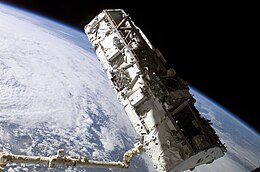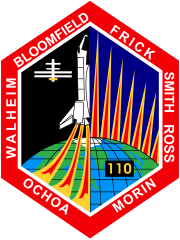STS-110
 Canadarm2 grapples the first segment of the ISS' Integrated Truss Structure | |
| Names | Space Transportation System-110 |
|---|---|
| Mission type | ISS assembly |
| Operator | NASA |
| COSPAR ID | 2002-018A |
| SATCAT no. | 27413 |
| Mission duration | 10 days, 19 hours, 43 minutes, 38 seconds |
| Distance travelled | 7,240,000 kilometers (4,500,000 mi) |
| Orbits completed | 171 |
| Spacecraft properties | |
| Spacecraft | Space Shuttle Atlantis |
| Launch mass | 116,609 kilograms (257,079 lb)[1] |
| Landing mass | 91,016 kilograms (200,657 lb)[1] |
| Payload mass | 13,132 kilograms (28,951 lb) |
| Crew | |
| Crew size | 7 |
| Members | |
| Start of mission | |
| Launch date | 8 April 2002 20:44:19 UTC |
| Launch site | Kennedy, LC-39B |
| End of mission | |
| Landing date | 19 April 2002 16:26:57 UTC |
| Landing site | Kennedy, SLF Runway 33 |
| Orbital parameters | |
| Reference system | Geocentric |
| Regime | Low Earth |
| Perigee altitude | 155 kilometres (96 mi) |
| Apogee altitude | 225 kilometres (140 mi) |
| Inclination | 51.6 degrees |
| Period | 88.3 minutes |
| Docking with ISS | |
| Docking port | PMA-2 (Destiny forward) |
| Docking date | 10 April 2002 16:05 UTC |
| Undocking date | 17 April 2002 18:31 UTC |
| Time docked | 7 days, 2 hours, 26 minutes |

 In front, (L-R): Stephen N. Frick, Ellen L. Ochoa, Michael J. Bloomfield; In the back, (L-R): Steven L. Smith, Rex J. Walheim, Jerry L. Ross and Lee M. E. Morin. | |
STS-110 was a Space Shuttle mission to the International Space Station (ISS) on 8–19 April 2002 flown by Space Shuttle Atlantis. The main purpose was to install the S0 Truss segment, which forms the backbone of the truss structure on the station.
Crew
[edit]| Position | Astronaut | |
|---|---|---|
| Commander | Michael J. Bloomfield Third and last spaceflight | |
| Pilot | Stephen N. Frick First spaceflight | |
| Mission Specialist 1 | Rex J. Walheim First spaceflight | |
| Mission Specialist 2 Flight Engineer |
Ellen L. Ochoa Fourth and last spaceflight | |
| Mission Specialist 3 | Lee M. E. Morin Only spaceflight | |
| Mission Specialist 4 | Jerry L. Ross Seventh and last spaceflight | |
| Mission Specialist 5 | Steven L. Smith Fourth and last spaceflight | |
Mission highlights
[edit]
The main purpose of STS-110 was to attach the stainless steel S0 Truss segment to the International Space Station (ISS) to the Destiny Laboratory Module. It forms the backbone of the station to which the S1 and P1 truss segments were attached (on the following missions STS-112 and STS-113, respectively).
STS-110 also delivered the Mobile Transporter (MT), which is an 885 kilograms (1,951 lb) (1,950 lb) assembly that glides down rails on the station integrated trusses. The MT was designed and manufactured by Astro Aerospace in Carpinteria, CA. During the next shuttle mission, STS-111, the Mobile Base System (MBS) was mounted to the MT. This Mobile Servicing System (MSS) allows the Canadarm2 to travel down the length of the installed truss structure.
Flight Day 1: Launch
[edit]After a launch scrub on 4 April 2002 due to a hydrogen leak, Space Shuttle Atlantis successfully launched on 8 April 2002, from Launch Complex 39B. The countdown on 8 April encountered an unscheduled hold at the T−5-minute mark due to data dropouts in a backup Launch Processing System. The Launch Processing System team reloaded the required data and the countdown resumed. Liftoff occurred with 11 seconds remaining in the launch window.[2]
STS-110 was the first shuttle mission to feature the upgrade Block II main engines, which featured an "improved fuel pump...a stronger integral shaft/disk, and more robust bearings". The intent of the upgrade was to increase the flight capacity of the engines, while increasing reliability and safety.[3]
With the launch of Atlantis, mission specialist Jerry Ross became the first human to have traveled to space seven times.[4]
| Attempt | Planned | Result | Turnaround | Reason | Decision point | Weather go (%) | Notes |
|---|---|---|---|---|---|---|---|
| 1 | 4 Apr 2002, 5:17:51 pm | Scrubbed | — | Technical | 4 Apr 2002, 9:27 am | 60% | Leak developed in a hydrogen fuel vent line.[5] |
| 2 | 8 Apr 2002, 4:39:31 pm | Success | 3 days 23 hours 22 minutes |
Crew seat assignments
[edit]| Seat[6] | Launch | Landing |  Seats 1–4 are on the flight deck. Seats 5–7 are on the mid-deck. |
|---|---|---|---|
| 1 | Bloomfield | ||
| 2 | Frick | ||
| 3 | Walheim | Morin | |
| 4 | Ochoa | ||
| 5 | Morin | Walheim | |
| 6 | Ross | ||
| 7 | Smith | ||
Spacewalks
[edit]| Mission | Spacewalkers | Start – UTC | End – UTC | Duration | Mission | |
|---|---|---|---|---|---|---|
| 35. | STS-110 EVA 1 |
Steven Smith Rex Walheim |
11 April 2002 14:36 |
11 April 2002 22:24 |
7 h, 48 min | Installed S0 Truss on Destiny |
| 36. | STS-110 EVA 2 |
Jerry Ross Lee Morin |
13 April 2002 14:09 |
13 April 2002 21:39 |
7 h, 30 min | Continued S0 Truss install |
| 37. | STS-110 EVA 3 |
Steven Smith Rex Walheim |
14 April 2002 13:48 |
14 April 2002 20:15 |
6 h, 27 min | Reconfigure Canadarm2 for S0 truss |
| 38. | STS-110 EVA 4 |
Jerry Ross Lee Morin |
16 April 2002 14:29 |
16 April 2002 21:06 |
6 h, 37 min | Install future EVA hardware |
Media
[edit]-
Launch video (1 minute 29 seconds)
-
The three newly enhanced Space Shuttle Main Engines ignite to launch Space Shuttle Atlantis, 8 April 2002
-
Astronaut Lee Morin on the second spacewalk
-
Space Shuttle Atlantis lands at the Shuttle Landing Facility, 19 April 2002
See also
[edit]- List of human spaceflights
- List of International Space Station spacewalks
- List of Space Shuttle missions
- List of spacewalks and moonwalks 1965–1999
- Outline of space science
References
[edit]![]() This article incorporates public domain material from websites or documents of the National Aeronautics and Space Administration.
This article incorporates public domain material from websites or documents of the National Aeronautics and Space Administration.
- ^ a b [1] "STS-110 Press Kit" (archived from Shuttlepresskit.com)
- ^ "NASA Mission Archives STS-110". National Aeronautics and Space Administration. Archived from the original on 3 March 2016. Retrieved 8 April 2012.
- ^ "MSFC-0200213". Marshall Space Flight Center. Archived from the original on 15 June 2011. Retrieved 28 November 2009.
- ^ "STS-110 Video Highlights". National Space Society. Archived from the original on 12 December 2013. Retrieved 28 November 2009.
- ^ "Propellant leak at pad forces launch delay". CBS News. Retrieved 30 August 2009.
- ^ "STS-110". Spacefacts. Retrieved 20 April 2024.
External links
[edit]- [2]
- NASA mission summary Archived 10 June 2016 at the Wayback Machine
- NASA shuttle mission archive Archived 3 March 2016 at the Wayback Machine
- Status reports – Detailed NASA status reports for each day of the mission.
- STS-110 Video Highlights Archived 12 December 2013 at the Wayback Machine





